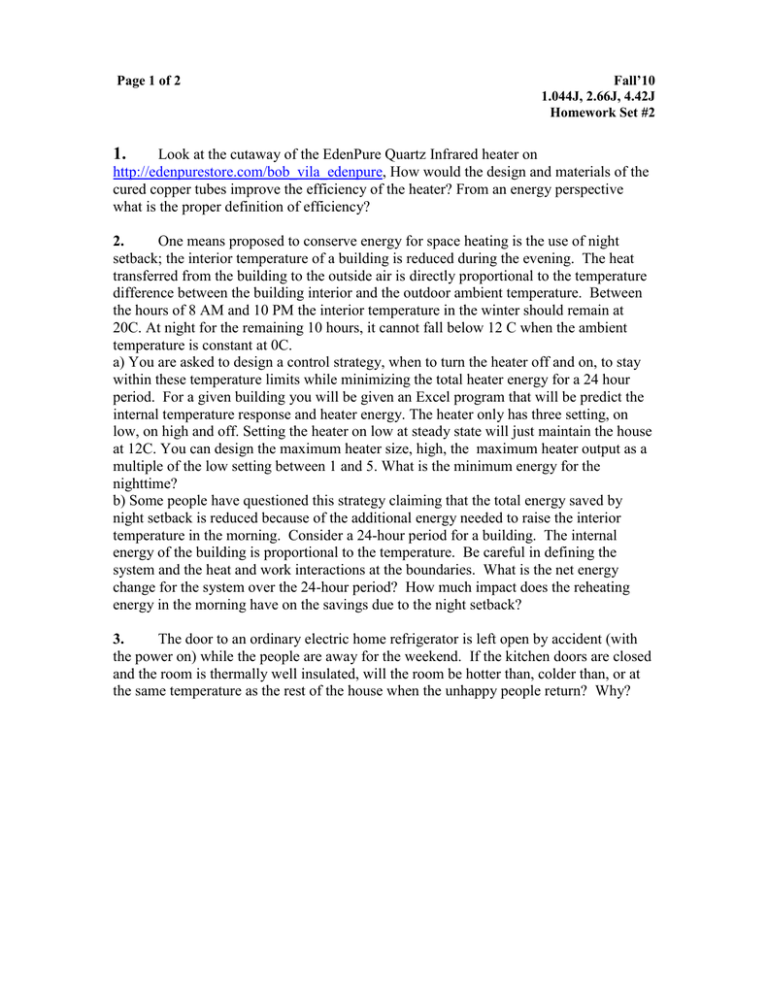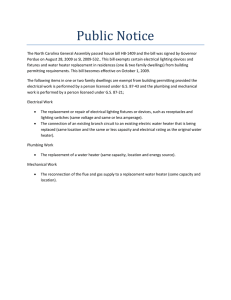1.
advertisement

Page 1 of 2 Fall’10 1.044J, 2.66J, 4.42J Homework Set #2 1. Look at the cutaway of the EdenPure Quartz Infrared heater on http://edenpurestore.com/bob_vila_edenpure, How would the design and materials of the cured copper tubes improve the efficiency of the heater? From an energy perspective what is the proper definition of efficiency? 2. One means proposed to conserve energy for space heating is the use of night setback; the interior temperature of a building is reduced during the evening. The heat transferred from the building to the outside air is directly proportional to the temperature difference between the building interior and the outdoor ambient temperature. Between the hours of 8 AM and 10 PM the interior temperature in the winter should remain at 20C. At night for the remaining 10 hours, it cannot fall below 12 C when the ambient temperature is constant at 0C. a) You are asked to design a control strategy, when to turn the heater off and on, to stay within these temperature limits while minimizing the total heater energy for a 24 hour period. For a given building you will be given an Excel program that will be predict the internal temperature response and heater energy. The heater only has three setting, on low, on high and off. Setting the heater on low at steady state will just maintain the house at 12C. You can design the maximum heater size, high, the maximum heater output as a multiple of the low setting between 1 and 5. What is the minimum energy for the nighttime? b) Some people have questioned this strategy claiming that the total energy saved by night setback is reduced because of the additional energy needed to raise the interior temperature in the morning. Consider a 24-hour period for a building. The internal energy of the building is proportional to the temperature. Be careful in defining the system and the heat and work interactions at the boundaries. What is the net energy change for the system over the 24-hour period? How much impact does the reheating energy in the morning have on the savings due to the night setback? 3. The door to an ordinary electric home refrigerator is left open by accident (with the power on) while the people are away for the weekend. If the kitchen doors are closed and the room is thermally well insulated, will the room be hotter than, colder than, or at the same temperature as the rest of the house when the unhappy people return? Why? Fall’08 1.044J, 2.66J, 4.42J Homework Set #2 Page 2 of 2 4. An investigator suggests use of a heat pump to provide winter heating to a building. Instead of using the outside air as the low temperature heat source, she proposes to use the domestic water system which enters the house at a higher temperature than the outside air. This raises the heat pump average coefficient of performance QH/W from 2.5 to 3.0. As the heat pump operates, Qw is transferred from the water, lowing TI, the inlet water temperature to the house. To simplify the consideration assume the initial water temperatures is TH same as the interior temperature. The house temperature is constant at TH. Evaluate the net energy electrical savings under two conditions: (a) (b) (c) W The water quickly flows through the house and there is no heat transfer between the water and the interior of the house. TD the water drain temperature equals TI with or without the heat pump. The water remains in the house for a long time. Heat transfer to the water in the house raises it temperature to the interior temperature TH, so that TD is equal to TH no matter how much TI changes. Comment on the feasibility of such a system. QH Heat Pump TH QW Water Inlet T = TH TI I m D m TD Drain MIT OpenCourseWare http://ocw.mit.edu 4.42J / 1.044J / 2.45J Fundamentals of Energy in Buildings Fall 2010 For information about citing these materials or our Terms of Use, visit: http://ocw.mit.edu/terms.

